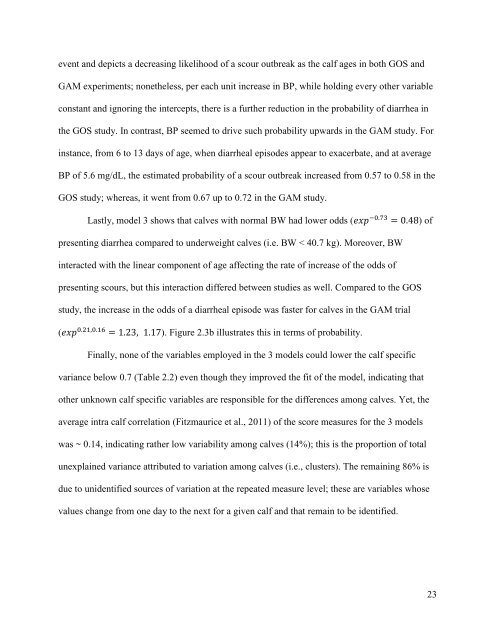Juan_Castro Marquez
Create successful ePaper yourself
Turn your PDF publications into a flip-book with our unique Google optimized e-Paper software.
event and depicts a decreasing likelihood of a scour outbreak as the calf ages in both GOS and<br />
GAM experiments; nonetheless, per each unit increase in BP, while holding every other variable<br />
constant and ignoring the intercepts, there is a further reduction in the probability of diarrhea in<br />
the GOS study. In contrast, BP seemed to drive such probability upwards in the GAM study. For<br />
instance, from 6 to 13 days of age, when diarrheal episodes appear to exacerbate, and at average<br />
BP of 5.6 mg/dL, the estimated probability of a scour outbreak increased from 0.57 to 0.58 in the<br />
GOS study; whereas, it went from 0.67 up to 0.72 in the GAM study.<br />
Lastly, model 3 shows that calves with normal BW had lower odds (<br />
) of<br />
presenting diarrhea compared to underweight calves (i.e. BW < 40.7 kg). Moreover, BW<br />
interacted with the linear component of age affecting the rate of increase of the odds of<br />
presenting scours, but this interaction differed between studies as well. Compared to the GOS<br />
study, the increase in the odds of a diarrheal episode was faster for calves in the GAM trial<br />
( ). Figure 2.3b illustrates this in terms of probability.<br />
Finally, none of the variables employed in the 3 models could lower the calf specific<br />
variance below 0.7 (Table 2.2) even though they improved the fit of the model, indicating that<br />
other unknown calf specific variables are responsible for the differences among calves. Yet, the<br />
average intra calf correlation (Fitzmaurice et al., 2011) of the score measures for the 3 models<br />
was ~ 0.14, indicating rather low variability among calves (14%); this is the proportion of total<br />
unexplained variance attributed to variation among calves (i.e., clusters). The remaining 86% is<br />
due to unidentified sources of variation at the repeated measure level; these are variables whose<br />
values change from one day to the next for a given calf and that remain to be identified.<br />
23



